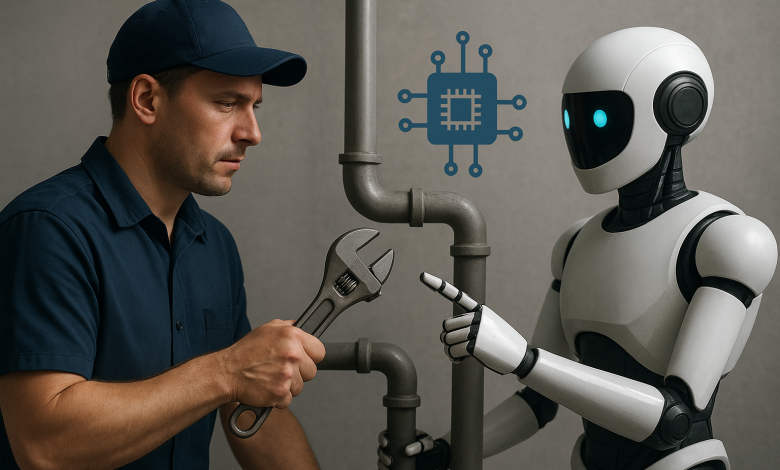
For decades, the trades have been defined by human expertise, as the seasoned electrician diagnoses a tricky fault, the plumber who knows the sound of a system about to fail, and the HVAC technician who reads a building’s rhythm like a musician reads notes. Yet, as artificial intelligence (AI) steadily enters this domain, the narrative is shifting. The question is no longer whether AI will impact the trades, but how humans and AI will collaborate to redefine them.
We’ve moved past the point of viewing AI as a replacement for workers. The conversation has matured. Across industries, executives now recognize that the highest value lies not in full automation, but in augmented intelligence. A partnership between skilled professionals and intelligent systems that amplifies human capability rather than erases it. Nowhere is this evolution more visible, or more promising, than in the skilled trades.
The Evolving Role of Skilled Labor in an AI-Driven World
AI’s presence in the trades is subtle but rapidly growing. Predictive maintenance systems, AI-driven scheduling platforms, and computer vision for safety monitoring are becoming staples on job sites. But behind each of these tools remains a human decision-maker who must interpret data, make judgment calls, and apply expertise in real-world conditions.
Tradespeople operate in dynamic and unpredictable environments, such as residential properties, construction sites, and manufacturing facilities, where each job presents unique challenges. This inherent variability has historically complicated efforts to fully automate these professions. However, artificial intelligence offers significant advantages by simplifying complexities, enhancing accuracy, and improving situational awareness for workers.
For example, take HVAC diagnostics. AI systems can now analyze sensor data to detect early signs of mechanical failure, which helps technicians fix problems before they get worse. But the technician still interprets those insights, considering things like the building’s layout, weather, and what the client needs. It’s a perfect example of collaboration, not replacement.
Where AI Adds Value and Where Humans Still Lead
Across industries, the narrative of “robots replacing workers” has proven misleading. In the trades, it’s particularly misplaced. The trades are built on craftsmanship, empathy, trust and human elements that AI can’t replicate. What it can do is help professionals operate at a higher level.
Here are four key areas where AI-human collaboration is already reshaping trade work:
1. Predictive Insights and Maintenance
AI can look at tons of equipment data in real time to predict when maintenance is needed, letting techs get ahead of problems instead of just reacting. But humans still decide how to use that info and when to step in. It’s about balancing data with good old common sense.
2. Smarter Workforce Scheduling
Smart scheduling tech can figure out the best daily routes by looking at traffic, how long jobs take, and what each technician is good at. But we still need people to step in when things go sideways like urgent calls, special customer requests, or those little local quirks that no computer can really understand.
3. Enhanced Safety and Risk Prevention
Computer vision can spot risky stuff on a job site before anyone gets hurt, sending alerts right away. But only a trained worker can really tell if it’s a real danger or just a false alarm. So, AI flags it, and people check it.
4. Training and Knowledge Retention
AI learning systems can throw apprentices into simulated repair situations or give real-time help with augmented reality. But you can’t beat a good mentor. The old-school master-apprentice way isn’t going away, it’s just getting a digital upgrade, blending hands-on learning with tech.
A Collaborative Future: Humans as Decision-Makers, AI as Force Multipliers
Leading organizations don’t see AI as a way to cut staff. Instead, they view it as a way to empower their team, enhance human decision-making, boost safety, and simplify operations.
In the trades, this idea pops up as hybrid workflows. Imagine an AI system that automatically predicts when a water heater is about to conk out. It gives the technician a heads-up, orders the part ahead of time, and sets up an appointment with the homeowner.The technician arrives informed, equipped, and ready to act. The AI handled all the behind-the-scenes stuff; the human brought the skill and awesome customer service.
This partnership means less waiting around, happier clients, and businesses getting more done with the same great team. Plus, it makes trade jobs way more appealing to younger, tech-smart folks who expect awesome digital tools to be part of their career toolkit.
According to McKinsey & Company, human-AI collaboration can improve productivity by up to 40% when properly integrated into daily workflows. This highlights the untapped potential in operational industries like the trades.
Bridging the Skills Gap with AI-Augmented Workflows
One of the most pressing challenges facing the trades today, especially in the U.S. and U.K. is the labor shortage. As older professionals retire, fewer young people are entering the trades. AI may not solve this entirely, but it can soften the impact.
AI tools can help accelerate training by turning complex tasks into guided digital experiences. For instance, virtual reality (VR) systems powered by AI can simulate electrical systems for apprentices to troubleshoot safely. Augmented reality (AR) overlays can show step-by-step repair instructions directly onto a technician’s field of view. These technologies make learning quicker and way more engaging, allowing new entrants to build confidence earlier in their careers.
A recent Deloitte report highlights that industries using AI-enabled training saw a 30% reduction in onboarding time for technical roles. For trade businesses, that’s a major advantage as it allows them to maintain productivity even as the workforce evolves.
At a strategic level, AI helps companies sustain performance not by replacing expertise, but by embedding it into intelligent systems that assist less-experienced workers.
The Human Element: Empathy, Adaptability, and Trust
No matter how advanced AI becomes, certain aspects of trade work will always demand a human touch. Customer interaction, situational judgment, and ethical decision-making remain firmly in human territory.
When a homeowner lets a tradesperson into their space, trust plays a defining role. AI might optimize communication or provide estimates, but it cannot reassure a nervous client or explain why a costly repair is necessary. The emotional intelligence and empathy of the human professional are what cement relationships and loyalty.
Moreover, humans are super adaptable. AI systems excel in structured environments but struggle with ambiguity. Tradespeople face constant unpredictability: a damaged pipe hidden behind a wall, unexpected wiring, or unique local regulations. Humans are built to figure out that stuff on the fly, and no computer can touch that yet.
The World Economic Forum reinforces this in its Future of Jobs Report 2025, emphasizing that “empathy, communication, and adaptability” are among the top human skills AI cannot replace, particularly in service-driven industries.
Strategic Implications for Business Leaders
For executives and decision-makers, the question is no longer whether to adopt AI, but how to structure collaboration between AI and their workforce.
The most successful companies are taking a human-centered AI strategy approach and investing in technologies that enhance human capability rather than eliminate it. This means:
- Choosing tools that integrate seamlessly with existing workflows.
- Involving frontline workers in the AI design process to ensure usability.
- Prioritizing explainable AI that builds trust rather than black-box automation.
- Investing in reskilling programs to help technicians adapt and thrive alongside new technologies.
PwC’s 2024 AI Business Outlook found that 60% of executives see “human-AI teamwork” as their most valuable AI investment. This pretty much shows everyone agrees that working with AI, not just having it do everything, is what really helps businesses grow.
Conclusion: The Trades as a Model for Human-AI Partnership
The trades are the perfect place to see human-AI collaboration in action. It’s an industry where hands-on skill, intuition, and judgment meet data-driven precision. As AI gets better, the companies that succeed will be those that embrace this collaboration thoughtfully, putting people at the center of the process.
In the end, AI doesn’t make the trades less human. It actually makes the human side of the trades even stronger. By combining both artificial and human smarts, we’re not just building smarter businesses. We’re building the future of work itself.
References:
https://www.mckinsey.com/capabilities/mckinsey-digital/our-insights/superagency-in-the-workplace-empowering-people-to-unlock-ais-full-potential-at-work
https://www.mckinsey.com/capabilities/quantumblack/our-insights/building-ai-trust-the-key-role-of-explainability
https://www.weforum.org/publications/the-future-of-jobs-report-2025/
https://www.deloitte.com/us/en/insights/topics/emerging-technologies/ai-adoption-in-the-workforce.html
https://www.pwc.com/gx/en/issues/artificial-intelligence/ai-jobs-barometer.html




